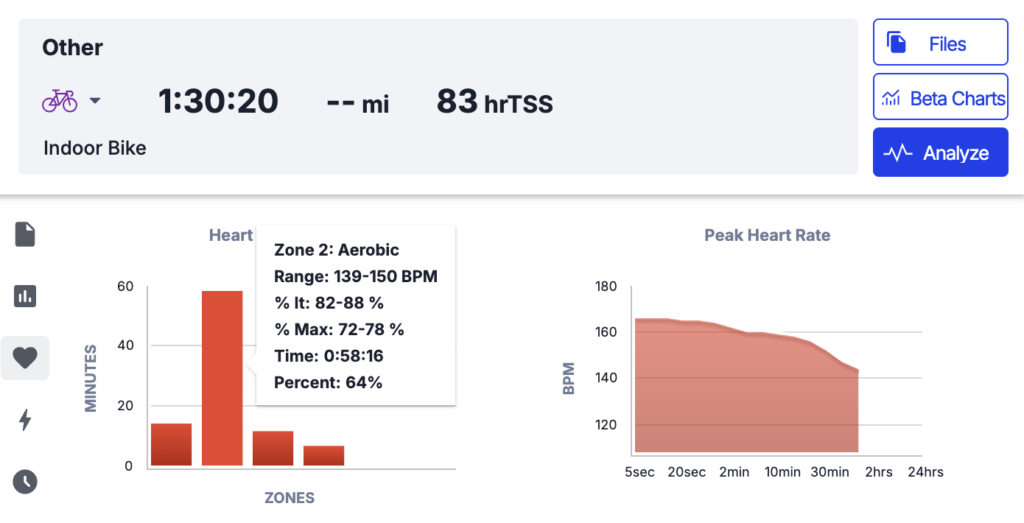If you’re training for an endurance goal, whether it’s finishing a marathon or completing an IRONMAN, chances are you probably follow some form of structured training. This training likely includes different training zones, intensities, and workouts spread throughout the week.
Every training zone serves a purpose. However, the most effective training plans prioritize Zone 2. This is arguably one of the most important aspects of endurance sports performance.
Many novice or young athletes fall into the trap of thinking the only way to get faster is to always train fast. Unfortunately, this causes them to miss out on performance gains by neglecting Zone 2.
Zone 2 training boosts your athletic performance on the cellular level. It improves your ability to utilize fat and effectively clear lactate, ultimately allowing you to train longer and get stronger.

Pro Athletes Don’t Skip Zone 2 Training
I have worked with professional and elite endurance athletes for more than 18 years, including cyclists, runners, triathletes, swimmers, and rowers. During this time, I’ve come to understand that Zone 2 training is paramount to improving performance.
Elite endurance athletes dedicate between 60-75% of their entire training time in Zone 2.
Very similar data across many different sports has been described by coaches worldwide, as well as in the scientific literature.
The purpose of each training zone is to elicit specific physiological and metabolic adaptations. Understanding what physiological and metabolic adaptations occur at different intensities can help you fine-tune and improve your training.
To know this, you first need to understand muscle metabolism.
Energy Metabolism in Athletes: The Role of ATP, Fats, and Carbs
An athlete’s exercise capacity ultimately depends on their ability to transform chemical energy into mechanical energy.
Skeletal muscle needs to synthesize adenosine triphosphate, or ATP, for muscle contraction.
ATP is a nucleotide responsible for the energy processes in human cells. It’s often called the “molecular unit of currency” for the cells, and it’s synthesized constantly during exercise.
ATP generation is achieved by two mechanisms: anaerobic and aerobic metabolism. Fats and carbohydrates (CHO) are the two substrates mainly used, with some contribution from protein.
Fat is primarily stored in adipose tissue, but it’s also stored in skeletal muscle in small amounts. Carbs are stored in the form of glycogen in skeletal muscle (about 80%) and in the liver (about 15%).
The exercise intensity (metabolic and physiological stress) as well as muscle fiber recruitment pattern dictate the energy system and substrate that is activated, which then correlate with different training zones.

Exercise Intensity and Substrate Utilization
The majority of exercise intensities generate ATP through aerobic metabolism, also called oxidative phosphorylation. Depending on the fitness level of an individual, ATP synthesis (energy) is generated from fat and carbohydrates, although carbs are used at small rates during low and moderate exercise intensities.
At higher exercise intensities (beyond 75% of VO2 max), ATP generation increases to maintain muscle contractile demands.
Fat cannot synthesize ATP fast enough, so carbohydrate utilization increases and becomes the predominant energy substrate. This is because energy synthesis derived from carbs is faster than fat.
Carbohydrates becomes the main energy substrate skeletal muscles use at exercise intensities up to 100% of VO2max. Beyond this intensity, ATP cannot be generated by aerobic glycolysis, so ATP needs to be generated through the anaerobic mechanism, also called substrate phosphorylation.
Essentially, going slowly lets your body use fats as fuel, and as you increase the pace, you increase the demand for carbohydrates.
Muscle Fiber Recruitment: Slow Twitch vs. Fast Twitch
Skeletal muscle consists of two kinds of muscle fibers — Type I, also known as slow twitch, and Type II, fast twitch.
Fast twitch fibers are also divided into two subgroups called Type IIa and IIb. Muscle fiber contraction follows a sequential recruitment pattern where Type I muscle fibers are recruited first.
As exercise intensity increases, muscle contractile demands increase, and Type I muscle fibers can’t sustain the demand. This is when Type IIa muscle fibers kick in, and eventually, as intensity keeps increasing, Type IIb are finally recruited.
Simply put, slow twitch fibers are used at slower speeds and fast twitch at faster speeds.
Each muscle fiber has different biochemical properties and, thus, different behaviors during exercise and competition.

What Muscle Fibers Are Used in Different Training Zones
Each exercise intensity requires different metabolic responses and muscle fiber recruitment patterns:
Type IIb muscle fibers have little mitochondrial density. These fibers mainly use glucose and ATP for instant anaerobic energy.
Type I muscle fibers have the highest mitochondrial density and capacity, making them very efficient at utilizing fat for energy.
Type IIa fibers have a lower mitochondrial density and a higher capacity to utilize glucose.

You stimulate Type I muscle fibers during Zone 2 training. Therefore, you stimulate mitochondrial growth and function, which improves your ability to utilize fat. This is key to performance for endurance athletes.
By improving your body’s ability to utilize fat as fuel, you preserve glycogen. You can then use that glycogen at the end of the race or workout when intensity increases.
Additional Benefits of Zone 2 Training
Besides fat utilization, Type I muscle fibers are also responsible for lactate clearance. Lactate is the byproduct of glucose utilization, which is used in large amounts by fast-twitch muscle fibers.
Lactate is mainly produced in fast-twitch muscle fibers. However, lactate needs to be cleared, or else it accumulates. This is when Type I muscle fibers play the key role of lactate clearance.
Type I muscle fibers contain a transporter called MCT-1, which takes up lactate and transports it to the mitochondria. It is then reused as reused as energy.
Zone 2 training increases mitochondrial density as well as MCT-1 transporters. This improves your ability to clear lactate, which is key for athletic performance.
Training Tip → Are you actually training in Zone 2? TrainingPeaks’ Time in Zones charts helps you see how much time you’re actually spending in each zone.

How Often Should You Train in Zone 2?
An endurance athlete should never stop training in Zone 2.
The ideal training plan should include 3-4 days a week of Zone 2 training in the first 2-3 months of pre-season training, followed by 2-3 days a week as the season gets closer and two days of maintenance once the season is in full swing.
Incorporating regular Zone 2 training into your routine not only boosts your endurance and fat utilization but also enhances your overall performance, making it an essential component for athletes at any level.

Learn more about Zone 2 researching and how pro athletes are using it, check out this CoachCast: Zone 2 Biochemistry for Biomechanical Energy with Iñigo San Millán.









